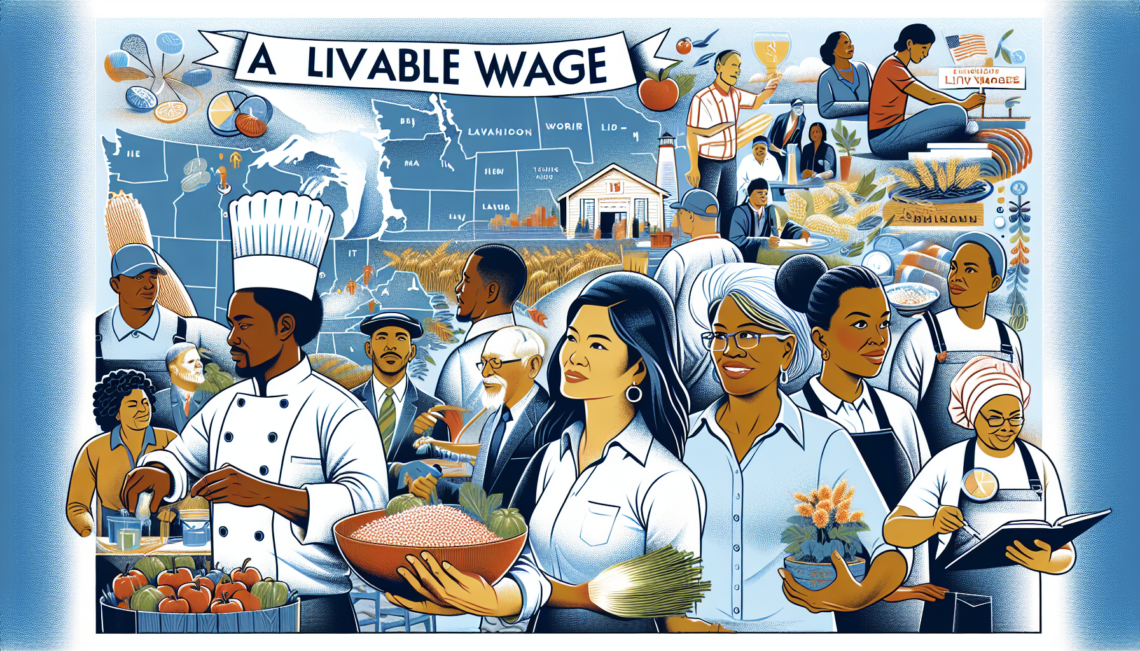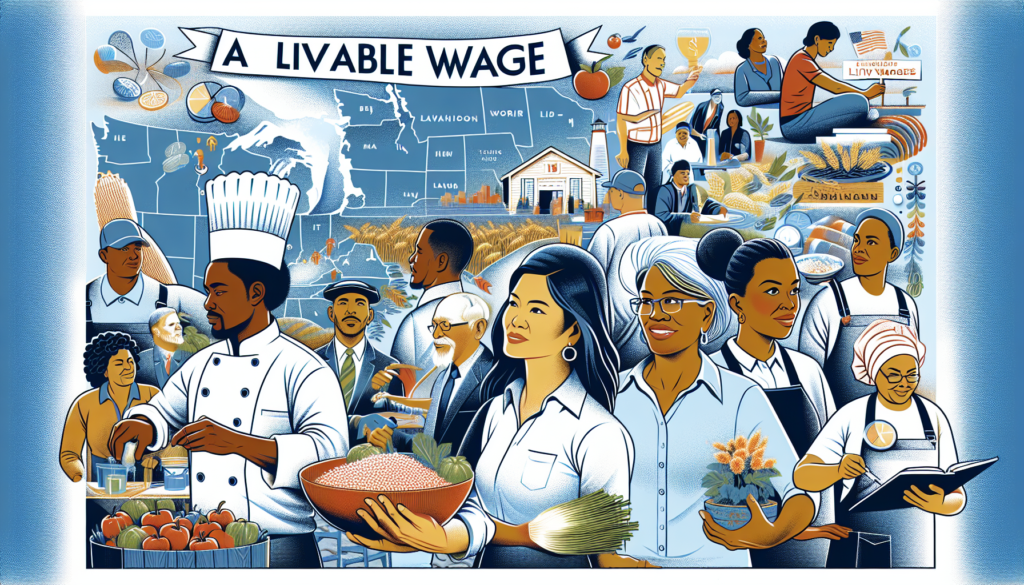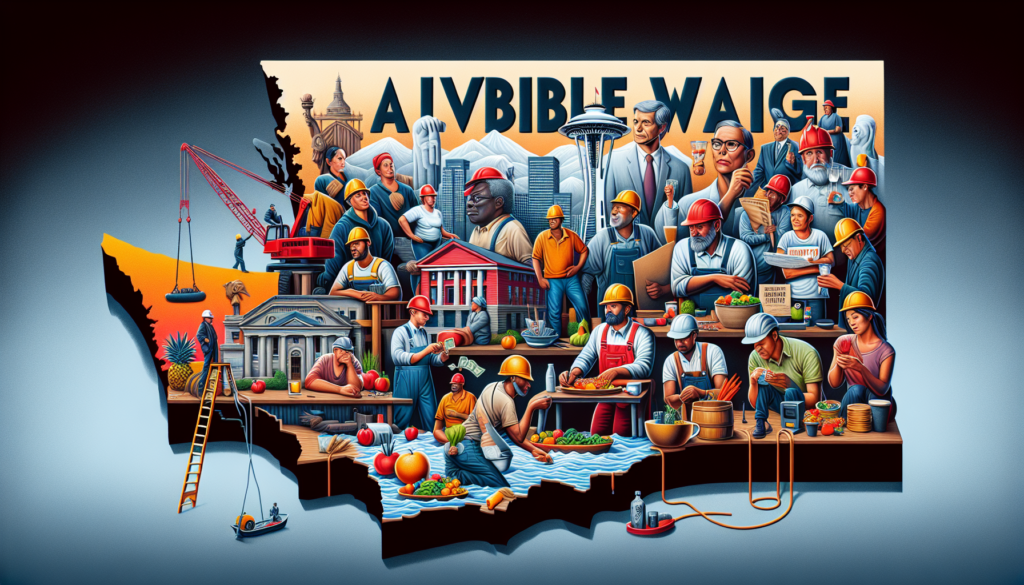
Exploring a Livable Wage in Washington State
Have you ever wondered what it takes to earn a livable wage in Washington State? In this article, we will explore the concept of a livable wage and delve into the specific details of what it means to make a comfortable living in this region. From understanding the cost of living to analyzing the minimum wage laws, we aim to provide you with a comprehensive look at the factors that contribute to a livable wage in Washington State. So, sit back, relax, and let’s embark on this fascinating journey together.
Table of Contents
ToggleDefining a Livable Wage
Basic Overview
A livable wage, also known as a living wage, refers to the minimum income required for an individual or family to meet their basic needs and maintain a decent standard of living. It takes into consideration the cost of housing, transportation, food, healthcare, and other living expenses in a specific geographic location. The concept of a livable wage is rooted in the belief that every worker deserves fair compensation that allows them to cover essential expenses without relying on public assistance.
Factors to Consider
Calculating a livable wage involves several factors that vary from region to region. The cost of living, which includes housing, transportation, food, healthcare, and other expenses, forms the foundation of these calculations. Additionally, family size, geographical location, and prevailing economic conditions are taken into account. It is important to consider both the necessities required for a basic standard of living and the ability to save for unforeseen circumstances or future goals. A livable wage should provide financial stability and prevent individuals and families from living paycheck to paycheck.
Calculating a Livable Wage
The calculations for a livable wage are complex and require a thorough analysis of the local economy. Various organizations, such as non-profits, think tanks, and government agencies, have developed methodologies to determine these wage benchmarks accurately. These calculations involve considering the costs of housing, transportation, food, healthcare, and other necessary expenses for different family sizes. Additionally, these calculations aim to ensure that a livable wage covers not only current expenses but also accounts for future financial goals, such as savings and investments.
Current Minimum Wage in Washington State
Introduction to Minimum Wage
The minimum wage is the legally mandated hourly pay rate that employers must provide to their employees. It serves as a legal protection for workers, ensuring they receive a fair compensation for their labor. The minimum wage varies from state to state and is subject to periodic revisions to keep up with the changing economic landscape and cost of living in each jurisdiction.
Minimum Wage Rates in Washington State
As of January 1, 2022, the minimum wage in Washington State is $14.49 per hour. However, this rate can differ based on the size of the employer and the presence of health insurance benefits for the employees. Small employers with fewer than 500 employees and no health insurance offer a minimum wage of $13.69 per hour. On the other hand, large employers with 500 or more employees or small employers who provide qualifying health insurance offer a minimum wage of $16.57 per hour.
Comparison with Federal Minimum Wage
The federal minimum wage in the United States is $7.25 per hour, significantly lower than Washington State’s minimum wage. Washington has consistently advocated for a higher minimum wage than the federal standard to reflect the higher cost of living in the state. This difference enables workers in Washington State to earn a more reasonable income that better aligns with their expenses and needs.

The Cost of Living in Washington State
Housing Expenses
Housing expenses account for a significant portion of an individual or family’s budget. In Washington State, the cost of housing varies widely depending on the region. The high demand and limited supply of affordable housing in urban areas like Seattle have led to skyrocketing rents and home prices. On the other hand, rural areas may have more affordable housing options but may lack job opportunities. These factors make housing affordability a crucial consideration when determining a livable wage in Washington State.
Transportation Costs
Transportation costs also play a vital role in the overall cost of living. Washington State offers a range of transportation options, including public transit, car ownership, and biking/walking infrastructure. The costs associated with these options, such as fuel, insurance, maintenance, and public transportation fares, can vary depending on an individual’s location and commuting needs. Considering transportation expenses is essential to ensure that a livable wage covers the cost of getting to work, accessing essential services, and maintaining a reasonable quality of life.
Food and Grocery Expenses
The cost of food and groceries is another crucial aspect of calculating a livable wage in Washington State. The state’s diverse agricultural industry and access to fresh produce contribute to a relatively lower cost of food compared to some other regions. However, factors such as dietary preferences, health conditions, and the need to purchase specialized or organic products can significantly impact an individual or family’s grocery budget. It is vital to account for these variations when determining a livable wage that supports a healthy and balanced diet.
Healthcare Costs
Access to quality healthcare is a fundamental requirement for individuals and families. Healthcare costs encompass insurance premiums, co-pays, deductibles, and out-of-pocket expenses. In Washington State, the availability of healthcare options varies based on factors such as income, employment, and residential location. It is essential to consider the potential costs associated with healthcare services, including preventive care, prescriptions, and unforeseen medical emergencies when determining a livable wage.
Other Living Expenses
Beyond housing, transportation, food, and healthcare, various other living expenses contribute to the overall cost of living in Washington State. These include utilities such as electricity, water, and internet services, as well as childcare, education, clothing, personal care items, and entertainment. It is important to consider these expenses comprehensively to ensure that a livable wage covers not only the necessities but also the ability to participate in community activities and maintain a reasonable quality of life.
Income Inequality in Washington State
Overview of Income Inequality
Income inequality refers to the unequal distribution of income among individuals or households within a society. It is a pressing issue that affects communities worldwide, including Washington State. Income inequality can impact various aspects of an individual’s life, including access to education, healthcare, and economic opportunities. Understanding the magnitude of income inequality is crucial in advocating for policies and initiatives that promote a livable wage and address the root causes of these disparities.
Key Statistics in Washington State
In Washington State, income inequality has been a long-standing concern. According to data from the U.S. Census Bureau, the state’s Gini coefficient, a commonly used measure of income inequality, was 0.428 in 2020. This coefficient indicates a moderate level of income inequality, with 0 representing perfect equality and 1 representing maximum inequality. Additionally, the top 20% of households in Washington State earned 50.1% of the total income, while the bottom 20% earned only 3.3%. These statistics highlight the significant income disparities that exist within the state.
Impacts on Livable Wage
Income inequality directly affects the ability of individuals and families to achieve a livable wage. Lower-income individuals often face challenges in accessing education, healthcare, and affordable housing, making it difficult to break the cycle of poverty. Rising income inequality can lead to wage stagnation, making it harder for low-income workers to bridge the gap between their earnings and the cost of living. Addressing income inequality is crucial to ensuring that a livable wage is attainable for all individuals in Washington State.

The Case for a Livable Wage
Economic and Social Benefits
Implementing a livable wage policy can result in significant economic and social benefits. When workers earn a wage that enables them to cover their basic needs, they are more likely to contribute to the local economy through increased consumer spending. This, in turn, can stimulate business growth, create more job opportunities, and boost overall economic activity. Additionally, a livable wage policy promotes social cohesion and reduces income inequality, contributing to a more equitable and inclusive society.
Reducing Reliance on Public Assistance
One of the key advantages of a livable wage is the potential reduction in reliance on public assistance programs. When workers earn a wage that adequately covers their basic needs, they are less likely to depend on government support to make ends meet. As a result, public funds can be redirected towards other essential services or utilized to invest in long-term societal development. By reducing the need for public assistance, a livable wage policy can contribute to a more efficient allocation of resources.
Improving Mental and Physical Health
Financial stability plays a crucial role in an individual’s overall well-being. When individuals are struggling to make ends meet, it can have a detrimental impact on their mental and physical health. Financial stress, anxiety, and inadequate access to healthcare can lead to long-term health issues and reduced quality of life. By ensuring a livable wage, individuals are relieved of some of these stressors, allowing them to invest in their health and well-being. This, in turn, can lead to improved productivity, reduced healthcare costs, and a happier and healthier workforce.
Challenges and Criticisms
Potential Job Losses
One of the main criticisms surrounding the implementation of a livable wage policy is the concern over potential job losses. Opponents argue that raising wages could lead to businesses reducing their workforce or cutting back on hours to compensate for increased labor costs. However, research on the effects of raising the minimum wage has shown mixed results. While some studies suggest minimal impacts on employment, others indicate potential job losses, particularly in industries with low-profit margins. Careful consideration and a phased approach to implementing livable wage policies are essential to mitigate any adverse effects.
Impact on Small Businesses
Small businesses often face unique challenges when it comes to adjusting to an increased minimum wage. Unlike larger corporations, they may have limited resources and profit margins, making it harder to absorb additional labor costs. Critics argue that raising the minimum wage could disproportionately burden small businesses, potentially leading to closures and job losses. However, it is important to note that small businesses can also benefit from a livable wage policy through increased consumer spending and improved employee retention. The potential effects on small businesses should be carefully studied and addressed to ensure a balanced and equitable implementation.
Inflationary Concerns
Another concern raised by critics is the potential inflationary impact of increasing wages. Critics argue that businesses may pass on the increased costs to consumers by raising prices, thereby eroding the purchasing power of a higher wage. However, empirical evidence on the relationship between minimum wage increases and inflation is inconclusive. Many studies have failed to establish a significant link between these factors, suggesting that the impact on prices may be limited. It is crucial to monitor and evaluate the potential effects on inflation when implementing a livable wage policy to ensure its overall effectiveness.
Existing Livable Wage Initiatives
City and County Level Efforts
Across Washington State, various cities and counties have taken the initiative to establish their livable wage policies. For example, in 2015, Seattle implemented a phased-in approach to increase the minimum wage to $15 per hour for large employers (with 500 or more employees) and $13.50 per hour for small employers over several years. Other jurisdictions, such as SeaTac and Spokane, have also enacted their own livable wage ordinances. These local initiatives recognize the unique cost of living challenges in their communities and aim to address them while supporting workers and local businesses.
Statewide Livable Wage Campaigns
In addition to local efforts, statewide campaigns have been instrumental in advocating for a livable wage in Washington State. Grassroots organizations, labor unions, and community leaders have mobilized to raise awareness about the need for fair compensation and address income inequality. These campaigns have sparked public dialogue, influenced policy discussions, and led to concrete actions aimed at establishing and improving livable wage standards across the state. Statewide initiatives play a crucial role in ensuring that a livable wage becomes a reality for all workers in Washington State.
Success Stories and Lessons Learned
Existing livable wage initiatives in Washington State provide valuable insights into the potential impact and challenges associated with implementing such policies. For instance, Seattle’s phased-in approach to a $15 minimum wage has shown mixed results. While some businesses have reported minimal negative impacts, others have faced challenges, particularly smaller businesses operating on narrower profit margins. These experiences highlight the need for comprehensive research, collaboration, and ongoing evaluation when crafting and implementing livable wage policies. By learning from both successes and failures, policymakers can develop effective strategies that balance the needs of workers and businesses.
Potential Strategies for Achieving a Livable Wage
Legislative Actions
Legislative actions play a fundamental role in establishing and enforcing livable wage policies. State and local lawmakers can introduce and pass legislation to increase the minimum wage or establish specific wage standards that align with the cost of living. These actions can be accompanied by provisions for phase-ins, exemptions, or regional adjustments to ensure a balanced approach that considers the diverse economic landscape within the state. Legislative efforts must also involve collaboration with stakeholders, including businesses, workers, and community organizations, to address concerns and ensure the feasibility and effectiveness of the proposed policies.
Labor Union Advocacy
Labor unions have historically played a crucial role in advocating for fair wages and workers’ rights. Through collective bargaining agreements, they negotiate for higher wages and better working conditions on behalf of their members. The collective power of unions can contribute to the establishment of livable wage standards not only for their members but also for the broader workforce. Labor unions can provide a platform for workers to voice their concerns, contribute to policy discussions, and shape the narrative surrounding fair compensation. By harnessing this collective strength, unions can drive positive change and promote the realization of a livable wage for all.
Private Sector Initiatives
The private sector can also play a significant role in ensuring a livable wage for workers. Some companies have taken voluntary steps to provide their employees with wages that exceed the legally mandated minimum. By doing so, these employers demonstrate a commitment to fair compensation and the overall well-being of their workforce. Additionally, businesses can implement policies and practices that prioritize employee benefits, support career development, and offer opportunities for advancement. These initiatives contribute to a more sustainable and equitable work environment that fosters economic security and long-term financial stability.
The Role of Government in Ensuring a Livable Wage
Minimum Wage Laws and Enforcement
Government entities at the state and local levels have a pivotal responsibility in establishing and enforcing minimum wage laws. These laws serve as the foundation for ensuring a livable wage for workers. Lawmakers must continuously review and adjust minimum wage standards to reflect changes in the cost of living and economic conditions. Additionally, effective enforcement mechanisms, such as labor departments and wage enforcement agencies, are essential to monitor compliance and ensure that workers receive the wages they are entitled to.
Supporting Affordable Housing
Access to affordable housing is a critical component of ensuring a livable wage. Government agencies can play an active role in supporting affordable housing initiatives, including rental assistance programs, low-income housing development, and tenant protections. By addressing the housing affordability crisis, policymakers can help alleviate the burden on workers and ensure that a larger portion of their income can be allocated to other essential needs. Moreover, strategic collaborations between government entities and private developers can promote the creation of affordable housing opportunities for low and middle-income individuals and families.
Investment in Education and Skills Training
Investments in education and skills training are indispensable in creating a pathway to higher wages and economic mobility. Governments can allocate resources to enhance access to quality education, vocational training, and lifelong learning opportunities. By equipping individuals with the necessary skills and qualifications, governments can empower workers to access higher-paying jobs, thereby increasing their earning potential. Additionally, fostering strong partnerships between educational institutions, employers, and community organizations can ensure that training programs align with current labor market needs, enhancing job prospects and wage growth.
Conclusion
Ensuring a livable wage is a multifaceted endeavor that requires a comprehensive understanding of the cost of living, income inequality, and the potential impacts on workers, businesses, and society as a whole. In Washington State, the current minimum wage falls short of providing workers with a truly livable income. By considering factors such as housing expenses, transportation costs, food and grocery expenses, healthcare costs, and other living expenses, policymakers can work towards establishing a fair and equitable wage that allows individuals and families to thrive.
Implementing livable wage policies offers numerous economic and social benefits, including increased consumer spending, reduced reliance on public assistance, and improved mental and physical health outcomes. However, challenges and criticisms, such as potential job losses, impact on small businesses, and inflationary concerns, must be addressed through careful planning and an evidence-based approach.
Existing livable wage initiatives at the city, county, and statewide levels provide valuable insights and lessons learned. Legislative actions, labor union advocacy, and private sector initiatives all play important roles in achieving a livable wage. The government’s role in ensuring a livable wage extends beyond minimum wage laws and enforcement; it involves supporting affordable housing, investing in education and skills training, and fostering partnerships between stakeholders.
By prioritizing the establishment of a livable wage, Washington State can take significant strides towards building a more inclusive, equitable, and prosperous society, where all residents have the opportunity to thrive and achieve their fullest potential.
You May Also Like

Exploring Eco-Friendly Initiatives in Vancouver Washington
3 September 2023
7 Reasons to LOVE Living in CAMAS, Washington! | Moving to Camas
15 August 2023





